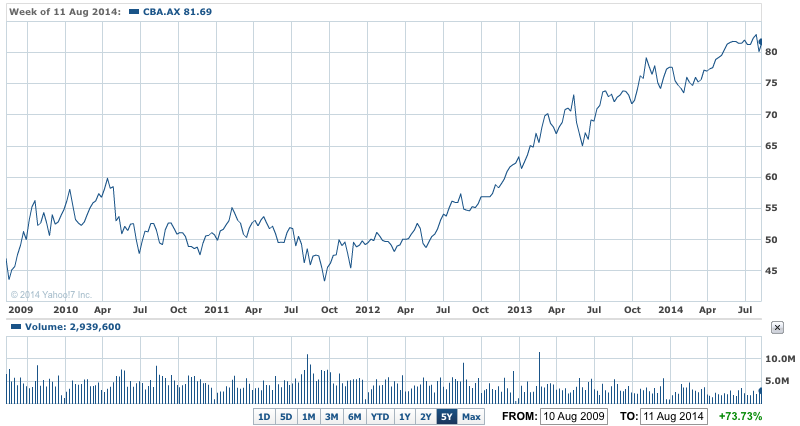There were no shocks in the record 2013-14 full year profit from the Commonwealth Bank (CBA) this morning.
The CBA lifted cash net profit 12% to $8.68 billion and will pay a total dividend for the year of $4.01 after lifting final dividend to $2.18 a share.
The final dividend was raised 9% on 2012-13, while the total payout for the year is up 10%.
Both the profit and the total dividend were in line with market forecasts.
For small investors, the dividend reinvestment plan (DRP) will again operate, but without a discount because the bank says it has more than enough capital.
The bank says that this year it will operate a share buyback in the market to neutralise the impact of shares issued under the DRP.
The CBA said its cost to income ratio again improved, falling 0.7% to 42.9%. the net interest margin (NIM) increased by 1 basis point over the year to 2.14%.
CBA 5Y – No suprises as CBA delivers again

CEO, Ian Narev said in this morning’s release “This result benefits a wide range of stakeholders, and we are proud of the role we have continued to play in building a strong Australia.
"During this financial year, we lent over $130 billion to Australian households and businesses, held $26 billion more deposits, and increased the investments we helped manage by over $20 billion.
"Our Australian-based shareholders, comprising nearly 800,000 households who own our shares directly and millions more who own them through their pension funds, received over $6.4 billion in dividends, and saw the value of their investment in the Commonwealth Bank increase by over $19 billion.
"We paid over $5.4 billion to more than 50,000 people whom we employ, continuing our commitment not to offshore Australian jobs. We spent $4 billion with local partners and suppliers, including hundreds of small businesses.
"We were one of Australia’s largest tax payers, paying around $3.4 billion in State and Federal tax. And we made significant contributions to support individuals, charities, sporting organisations and communities’ right across Australia,” he said.
Looking to the coming year, Mr Narev was cautious, saying lower interest rates were boosting key sectors.
"Lower interest rates have been positive for the housing and construction sectors, where increased activity has gone some way to offset the impacts of the anticipated reduction in investment in the resources sector," he said in a statement.
“If the stability in global markets continues, gradual increases in consumer spending and demand for credit from businesses over the next year are likely, as long as budget discussions are progressed and there is a clear understanding of Australia’s medium to long term economic direction.”













